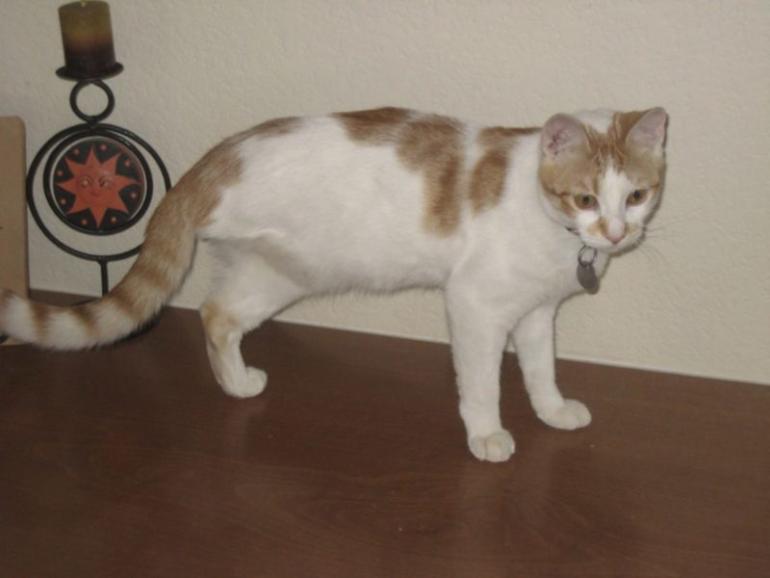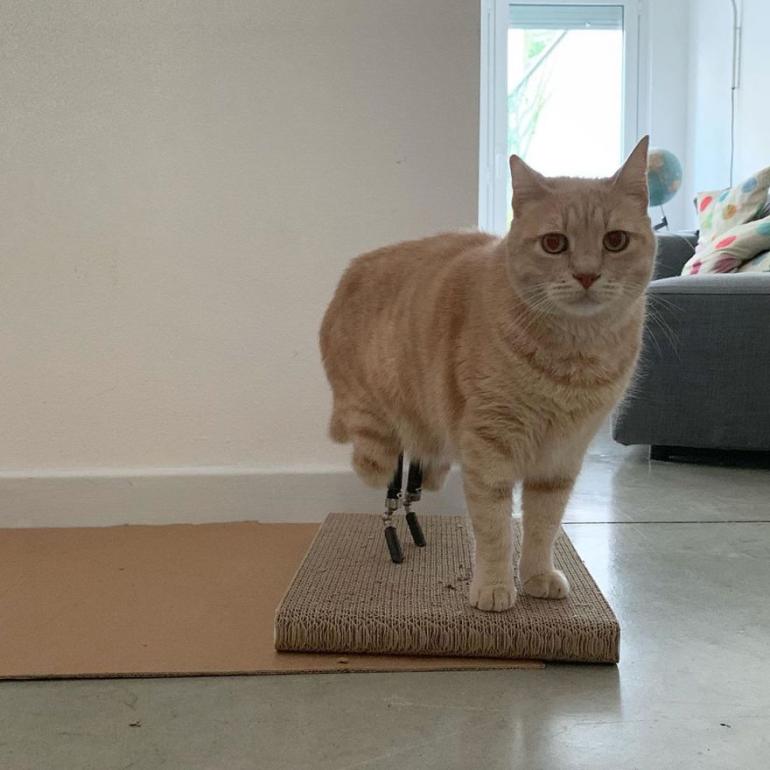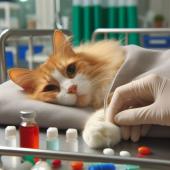Amputation - post-operative care

When Is Amputation Necessary?
Amputation in cats is typically considered when:
-
Severe Injury: Cats involved in accidents may suffer irreparable damage to a limb, making amputation the best option to relieve pain and prevent complications.
-
Cancer: Tumors or cancers affecting the bones or soft tissues may require amputation to remove the affected limb and prevent the spread of cancerous cells.
-
Chronic Disease: Conditions like severe arthritis or deformities might cause constant pain, making amputation a viable solution to improve the cat's overall quality of life.
The Amputation Procedure
Amputation surgery involves the removal of a limb, tail, or part of a limb. The procedure is performed under general anesthesia, ensuring the cat feels no pain during the surgery. Following the surgery, your cat will require appropriate pain management and wound care.
Amputation - post-operative care
There are several situations in which an animal's leg may need to be amputated. The two most frequent ones are severe trauma (from a car accident, for instance) and leg cancer care.
Generally speaking, cats handle amputation far better than people think they will. Since humans can only have two legs, missing one would leave them with just one. Since cats have four legs, they will still have three after losing one.


Will my cat miss having four legs?
Many times, owners believe that cats feel the same emotions as people, however this may not always be the case. We do know, though, that cats are incredibly adept at adjusting to new environments. The majority of veterinarians who treat cats who have had amputations indicate that these animals do not exhibit any symptoms of emotional instability. The majority of cats who have a leg amputated do so to alleviate a serious, frequently fatal illness. These patients almost always have a very painful ailment that affects the limb that has to be amputated. After an amputation, the patient is frequently happier and more at ease right away.
How long will my cat take to recover from surgery?
The speed at which most animals regain mobility following a leg amputation is astounding. Within 24 hours of the procedure, patients who do not have any other movement problems—such as osteoarthritis—should be able to move around their kennel. Within 12 hours, young cats should be able to walk on three legs.
Your cat will often spend a few days in the hospital following surgery if they have an amputation. The patient will require routine examinations by the veterinary staff to make sure the wound is healing appropriately and to administer the right amount of pain medication. The patient will begin to acclimate to life on three legs during this period. After surgery, most cats could jog for five to ten meters in three days.
To allow the surgical wound to heal, the cat's exercise regimen will need to be severely limited for two weeks following the procedure. Patients should be given the opportunity to potter in a garden or engage in guided exercise for a maximum of five to ten minutes at a time in order to use the restroom. The cat will start to acclimate and develop new muscle patterns for moving in a different manner.
When Is Amputation Necessary?
Amputation in cats is typically considered when:
-
Severe Injury: Cats involved in accidents may suffer irreparable damage to a limb, making amputation the best option to relieve pain and prevent complications.
-
Cancer: Tumors or cancers affecting the bones or soft tissues may require amputation to remove the affected limb and prevent the spread of cancerous cells.
-
Chronic Disease: Conditions like severe arthritis or deformities might cause constant pain, making amputation a viable solution to improve the cat's overall quality of life.
The Amputation Procedure
Amputation surgery involves the removal of a limb, tail, or part of a limb. The procedure is performed under general anesthesia, ensuring the cat feels no pain during the surgery. Following the surgery, your cat will require appropriate pain management and wound care.
Recovery and Rehabilitation
The recovery period after amputation can be challenging, but with proper care and support, cats can adapt remarkably well. Here are some essential aspects of post-amputation care:
-
Pain Management: Your veterinarian will prescribe pain medications to keep your cat comfortable during the recovery process.
-
Wound Care: Regular wound cleaning and monitoring for signs of infection are crucial. Follow your vet's instructions on cleaning and dressing the incision site.
-
Physical Therapy: Physical therapy and gentle exercises can help your cat regain strength and mobility. Your vet or a specialized therapist can guide you on appropriate exercises.
-
Adjustment Period: Cats may experience a period of adjustment as they learn to balance and move without the missing limb. Provide a safe and quiet environment to help your cat adapt at their own pace.
-
Environmental Modifications: Make necessary adjustments at home, such as providing low-sided litter boxes, ramps, and comfortable bedding to facilitate your cat's movements.
-
Emotional Support: Cats may feel stressed or anxious after amputation. Offer plenty of love, attention, and reassurance to help them feel secure.
What will my cat look like after surgery?
Following an amputation, your cat will have a huge shaved region and one or more lines of stitches or staples where the surgery was done when they get home. Significant bruises are frequently visible beneath the skin, where blood may have seeped during surgery. Similar to a typical bruise, this is not unpleasant.
Will my cat be in pain?
Of course, if proper pain medication was not provided, surgery would be excruciating. It is likely that your veterinarian may prescribe a potent analgesic, such methadone, along with non-steroidal anti-inflammatory pain relievers. In order to prevent pain from developing, these medications are typically started prior to surgery and continued following it. Strong pain relievers are usually administered for one to three days, while non-steroidal anti-inflammatory pain relievers are administered for one to two weeks and are consequently continued at home after the patient is released from the hospital. In certain facilities, a local anesthetic is used at the surgical site both prior to the procedure and for one to three days following it to give further pain relief. This increases the patient's comfort even further.
Patients who have a well-planned and executed pain management strategy experience constant comfort.
Phantom leg pain
Some amputees in humans suffer from a crippling ailment called phantom limb pain. Their brain informs them that the excruciatingly painful sensation they are feeling is related to the missing arm or limb. Notably, there has never been any documentation of phantom limb discomfort in animals. It is obvious that diagnosing phantom leg pain in animals is not a reliable method, but if cats were in pain following surgery, they would have displayed some indication of it.
What wound management should I expect to have to do?
Owners shouldn't anticipate needing to handle any serious wounds. Every day, you should examine the wound for any indications of discomfort or inflammation. These include of pain, redness, swelling, heat, and discharge. This is due to the fact that each surgery carries a danger of post-operative bleeding or infection, and by promptly identifying the symptoms of either, the patient's risks can be reduced. Get in touch with your cat's veterinary staff if you have any concerns about how the wound is looking. Asking and discovering there was nothing to be concerned about is preferable to leaving things and later realizing you need to have taken action sooner.
Should I make any modifications to the house?
Some cats are not more active following operation than they were before to amputation. To guarantee that they have an excellent quality of life, the only changes that would be required could be as simple as moving their favorite bed from the sofa to the floor, where they won't have any trouble getting in. Active cats might need their owners to employ a bit more creativity to make sure they can continue to enjoy a high perch in the house or garden. Stools or boxes can be used as stairs to help the cat go up onto a favorite location on the bed or lounge furniture in the near term, a few weeks following surgery. When they become more mobile, some owners build creative wooden ramps that could offer a secure path from the ground to a favored perch, like the garden shed's roof.
How long does it take before they can exercise normally?
Most cats should not exercise for the first two weeks following surgery. They adjust to having three legs perfectly throughout this period, and at the end of the two weeks, they will be able to move around the house's first floor in a satisfactory manner. After two weeks, slender cats that don't have any additional medical conditions will be able to climb and descend stairs. It may be partially due to motivational issues that obese cats require more time to adjust. Losing weight is crucial to their continued care, both for their own mental health and the health of their remaining limbs.
Does amputation place excessive strain on the other limb?
Without a doubt, the limb on the opposite side of the body must perform the duties of two after an amputation. Your cat will have to modify its gait and posture, which will cause some weight to be redistributed. Amputees rarely get damage to their muscles or tendons. It is true that obese cats are more likely to experience additional complex medical conditions like diabetes mellitus. Regaining weight is essential to the post-operative care of obese feline amputees.
Why wouldn't people choose amputation if a limb is useless and very painful?
Some patients are just not suitable candidates for amputation. It is important to think about how an amputation would affect the cat's normal way of life and whether it would significantly disrupt their emotional state. For some cats, resting on the shed roof is their only source of happiness. It may not be suitable to amputate them if it is not realistic to expect them to perform this action again.
We believes that arthritis alone does not constitute a valid reason for choosing not to perform an amputation, especially since the conditions we are treating with amputation are typically extremely painful and can be relieved with a single surgical procedure. Osteoarthritis is often cited as a reason not to perform an amputation, but there are incredibly effective medications for arthritis.
A cat must be able to adjust to life on three legs in order to recover from amputation properly. Typically, cats with spinal issues are unable to accomplish this. While diabetic cats and obese cats are not good candidates for amputation, this does not mean that they shouldn't undergo surgery if it is necessary. In these situations, it is crucial that the owners and the veterinary team recognize the significance of managing diabetes or losing weight.
It is regrettably true that one reason cats may be considered for amputation is cancer. Before the disease is diagnosed, some bone malignancies do spread (metastasize), and many of them actually spread from other parts of the body. Therefore, surgery cannot be considered a cancer cure.
Long-Term Care and Quality of Life
With proper care and a supportive environment, cats can lead fulfilling lives after amputation. Regular veterinary check-ups are essential to monitor your cat's overall health and address any concerns promptly. Many cats continue to enjoy play, cuddles, and a good quality of life after adjusting to their new physical condition.
Conclusion
Amputation in cats, though a difficult decision, can significantly improve their well-being and alleviate pain associated with injuries, diseases, or cancer. With the right care, love, and patience, cats can adapt remarkably well to their new circumstances. As a responsible cat owner, providing emotional support, appropriate post-operative care, and a safe environment will go a long way in ensuring your feline friend's continued happiness and quality of life.



